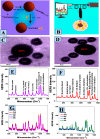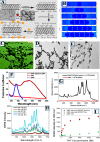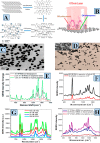Nanoarchitecture Based SERS for Biomolecular Fingerprinting and Label-Free Disease Markers Diagnosis
- PMID: 27993003
- PMCID: PMC5178832
- DOI: 10.1021/acs.accounts.6b00384
Nanoarchitecture Based SERS for Biomolecular Fingerprinting and Label-Free Disease Markers Diagnosis
Abstract
Surface-enhanced Raman spectroscopy (SERS) fingerprinting is highly promising for identifying disease markers from complex mixtures of clinical sample, which has the capability to take medical diagnoses to the next level. Although vibrational frequency in Raman spectra is unique for each biomolecule, which can be used as fingerprint identification, it has not been considered to be used routinely for biosensing due to the fact that the Raman signal is very weak. Contemporary SERS has been demonstrated to be an excellent analytical tool for practical label-free sensing applications due its ability to enhance Raman signals by factors of up to 108-1014 orders of magnitude. Although SERS was discovered more than 40 years ago, its applications are still rare outside the spectroscopy community and it is mainly due to the fact that how to control, manipulate and amplify light on the "hot spots" near the metal surface is in the infancy stage. In this Account, we describe our contribution to develop nanoachitecture based highly reproducible and ultrasensitive detection capability SERS platform via low-cost synthetic routes. Using one-dimensional (1D) carbon nanotube (CNT), two-dimensional (2D) graphene oxide (GO), and zero-dimensional (0D) plasmonic nanoparticle, 0D to 3D SERS substrates have been designed, which represent highly powerful platform for biological diagnosis. We discuss the major design criteria we have used to develop robust SERS substrate to possess high density "hot spots" with very good reproducibility. SERS enhancement factor for 3D SERS substrate is about 5 orders of magnitude higher than only plasmonic nanoparticle and more than 9 orders of magnitude higher than 2D GO. Theoretical finite-difference time-domain (FDTD) stimulation data show that the electric field enhancement |E|2 can be more than 2 orders of magnitude in "hot spots", which suggests that SERS enhancement factors can be greater than 104 due to the formation of high density "hot spots" in 3D substrate. Next, we discuss the utilization of nanoachitecture based SERS substrate for ultrasensitive and selective diagnosis of infectious disease organisms such as drug resistance bacteria and mosquito-borne flavi-viruses that cause significant health problems worldwide. SERS based "whole-organism fingerprints" has been used to identify infectious disease organisms even when they are so closely related that they are difficult to distinguish. The detection capability can be as low as 10 CFU/mL for methicillin-resistant Staphylococcus aureus (MRSA) and 10 PFU/mL for Dengue virus (DENV) and West Nile virus (WNV). After that, we introduce exciting research findings by our group on the applications of nanoachitecture based SERS substrate for the capture and fingerprint detection of rotavirus from water and Alzheimer's disease biomarkers from whole blood sample. The SERS detection limit for β-amyloid (Aβ proteins) and tau protein using 3D SERS platform is several orders of magnitude higher than the currently used technology in clinics. Finally, we highlight the promises, major challenges and prospect of nanoachitecture based SERS in biomedical diagnosis field.
Conflict of interest statement
The authors declare no competing financial interest.
Figures






References
-
- World Health Organization. Worldwide Country Situation Analysis: Response to Antimicrobial Resistance. 2015.
-
- Tackling Drug-Resistant Infections Globally: Final Report and Recommendations (http://amr-review.org/) (accessed March. 17, 2016).
Publication types
MeSH terms
Substances
Grants and funding
LinkOut - more resources
Full Text Sources
Other Literature Sources
Miscellaneous

